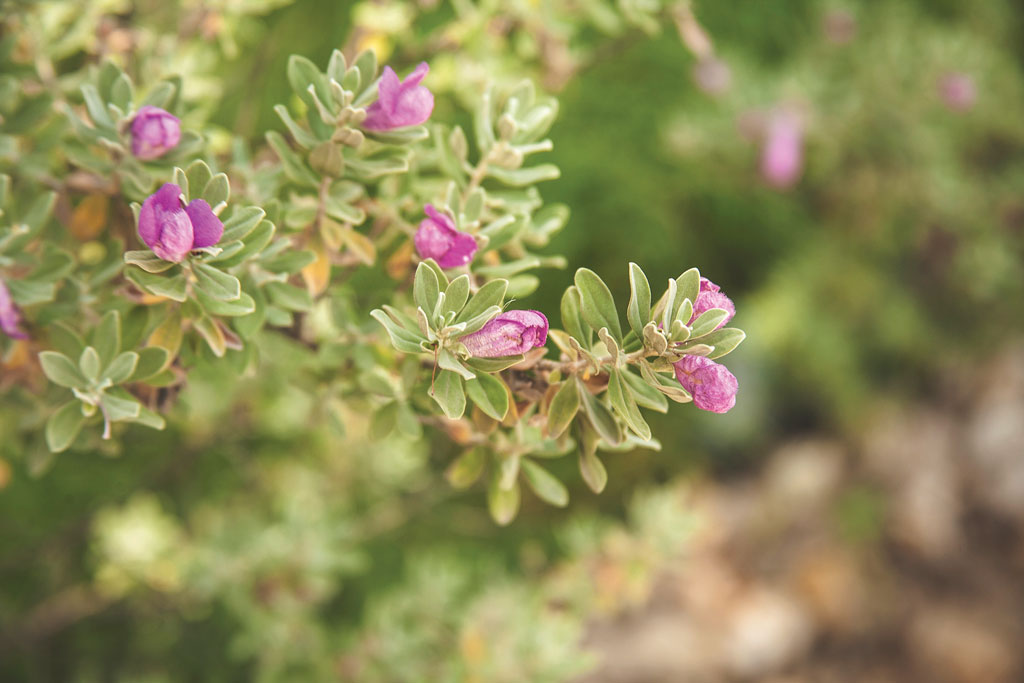
A copper-rumped hummingbird delights in a red bird of paradise blossom, a Texas native with a tropical look. Gardeners can depend on bright color all summer as this plant is particularly heat-tolerant. Minimal care includes pruning for shape only and mulching to protect the roots in winter.
Plants have to be really tough to live in Texas. Plants native to the Highland Lakes are resilient, beautiful, and a perfect fit for any yard, garden, or landscape, according to Sheryl Yantis, a Master Naturalist who lives on the shores of Lake LBJ in Kingsland. There, she grows a colorful variety of plants that don’t need much water or require fertilizers or pesticides. They also provide necessary habitat for bees and butterflies.
Yantis has proven as tough as the native plants she loves. The floods of October 2018 took out three-quarters of her extensive garden. Because most of the plants were native, she expects them to survive and eventually thrive once again.
“My garden is non-existent right now,” Yantis said, “but it will come back. This summer is going to be tough. I have to wait and see what I have left.”
While waiting, she and her husband, Robert, replaced downed purple martin houses and cleared debris to make way for the natives to revive and replenish. She’s not worried.
“Native plants adapt,” she said. “They have adapted over centuries to the lack of soil, the heat, and the alkalinity. Even the water here is alkaline.”
She knows this because she tests the water at the Kingsland Slab on a regular basis.

Leucophyllum frutescens, or Texas sage, is extremely drought-tolerant but typically blooms after a good rain. Its gray-green leaves stay healthy year-round. Best feature ever: The older it gets, the more intensely it blooms, so it’s a favorite of bees.
Plants that grow in the Highland Lakes have adapted to thin top soil, granite gravel, and caliche. They have to live in temperatures that can drop to 9 degrees in the winter and typically climb into the 100s in the summer. Water is scarce and expensive despite the lakes that cut through the terrain. Yantis has learned to plant around granite boulders and in rocky, unforgiving soil.
A native of the lush Northwest, Yantis thrives on the challenge as much as the plants do.
“I’m all about growing Texas,” she said. “I used to grow rhododendrons and azaleas, but I like all plants, especially plants that have been in an area long before you ever got there.”
To discover which plants appeal to you, she suggests looking around at the landscape — not at what people have in their yards but what is growing in the wild. She recommends a wide variety of sages for a mixed color palette year-round.
“Everything has a place and a purpose,” Yantis continued. “I can’t say there’s any one or several plants that you shouldn’t grow. It all depends on where you’re going to grow it or what you want it for.”
For example, some homeowners plant agarita bushes under windows. The thorns deter people from climbing in and out of windows, whether burglars or errant teens.
“What I might not care for, you might have a reason for,” Yantis said. “A weed is only a plant that’s out of control. There isn’t a plant that doesn’t have a purpose and place.”
For advice on what might work best for each person’s needs, she suggested the Grow Green Plant Guide published by the city of Austin.
Once you’ve decided, several local nurseries will most likely have the plants on hand.
“We really need natives,” Yantis said. “All of our area wildlife has evolved with these plants, all the good insects, everything. That’s my main concern. That’s why I plant natives.”
suzanne@thepicayune.com











